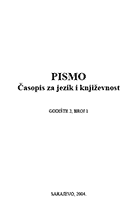Prilog klasifikaciji glagolskih vremena u perzijskom jeziku
A contribution to the classification of tenses in Persian language
Author(s): Sabaheta GačaninSubject(s): Language and Literature Studies
Published by: Bosansko filološko društvo
Keywords: perzijski jezik; klasifikacija glagolskih vremena; glagolski korijen i glagolska osnova; tvorba; semantika
Summary/Abstract: The modern Persian verbal forms are all complex forms constructed from four linguistics items: the aspect marker, the verbal root, the tense marker and appropriate person-number suffix. The two main terms of Persian tense system are past and non-past that are marked morphologically on the verb by the presence and absence of past tense marker. The past tense marker is realized as /-t/, /-d/ or /- id/ depending on the phonological context of the given verb. Each Persian irregular verb has two roots: a past and a non-past; the regular verbs have just a single root for both the past and non-past tense. Term ”past stem” is used to refer to the combination of (past) root and tense archisegment /D/. The verbal forms that are constructed from non-past root are non-past perfective (present), non-past imperfective and imperative, and forms that are constructed from the past stem are perfective past (simple past), imperfective past (imperfect), perfect imperfective, progressive imperfective perfect, perfect subjunctive and double perfect.
Journal: Pismo - Časopis za jezik i književnost
- Issue Year: 2004
- Issue No: 02
- Page Range: 70-83
- Page Count: 14
- Language: Bosnian

